Lunch with Eamon Ore-Giron: For the Peruvian American artist, tiny Intiraymi offers the taste and feel of Peru
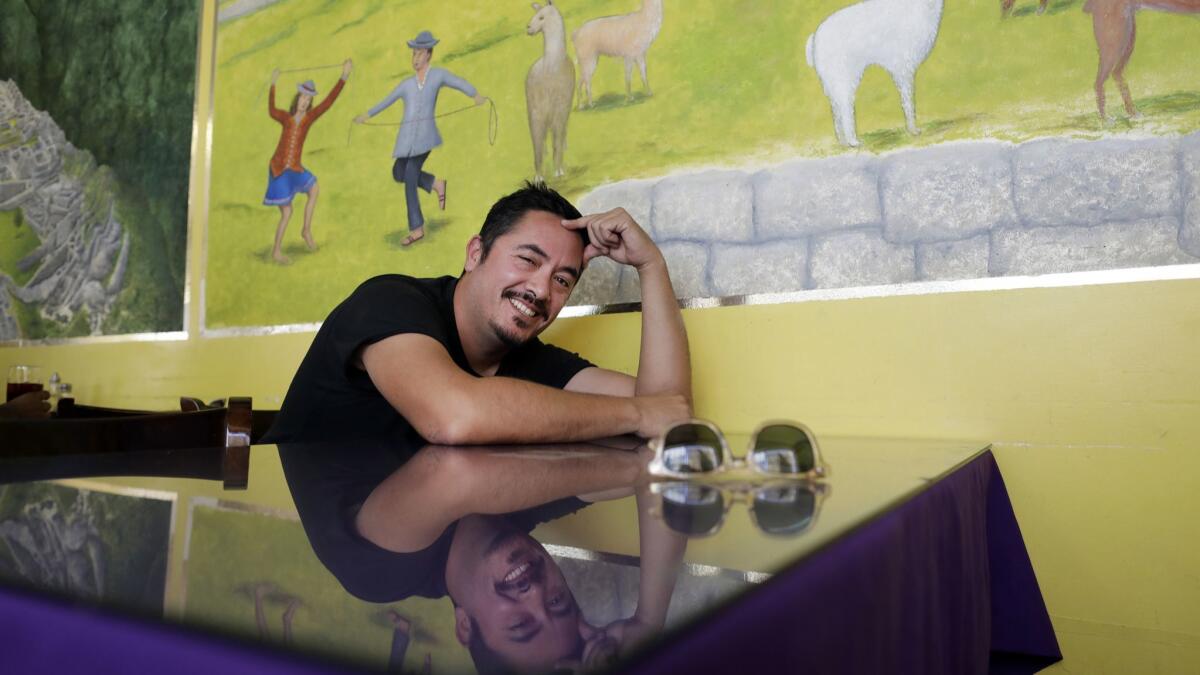
In the great taxonomy of Los Angeles strip malls, the one that resides at the corner of Cesar Chavez Avenue and Spring Street in downtown sits somewhere on the continuum between utilitarian and grim. The structure is squat stucco. Parking is impossible. Shop facades are obscured by awnings that serve as faded shields against the afternoon sun. For a time, its most prominent business peddled bail bonds.
For 19 years, Peruvian restaurant Intiraymi has occupied a corner spot on this mall, its principal marker a sign that bears a plastic chicken enveloped in plastic flame and an improvised wall of mesquite wood that stands before the front door. For 10 of those years, Peruvian American artist Eamon Ore-Giron has been a regular patron, materializing for the bountiful lunch specials ($9.95 — soup and bread included), and their well-rendered seco de cordero, lamb stew simmered in cilantro and corn beer.
“There is something very ’80s about this place,” says Ore-Giron as he dips into the plate of seco before him. “It reminds me of Lima — the light, when it’s super foggy, and you’ve been living under fluorescent lighting in a concrete room.”
Intiraymi is one of those spots that quietly powers Los Angeles — a local joint preoccupied with the day-to-day act of feeding a neighborhood. On a given afternoon, customers include construction workers, office clerks, Asian twenty-somethings in Dodgers gear, gaggles of Latin American immigrants in assorted national flavors, and government employees who drop in late in the day to pick up a spit-roasted chicken before heading home.
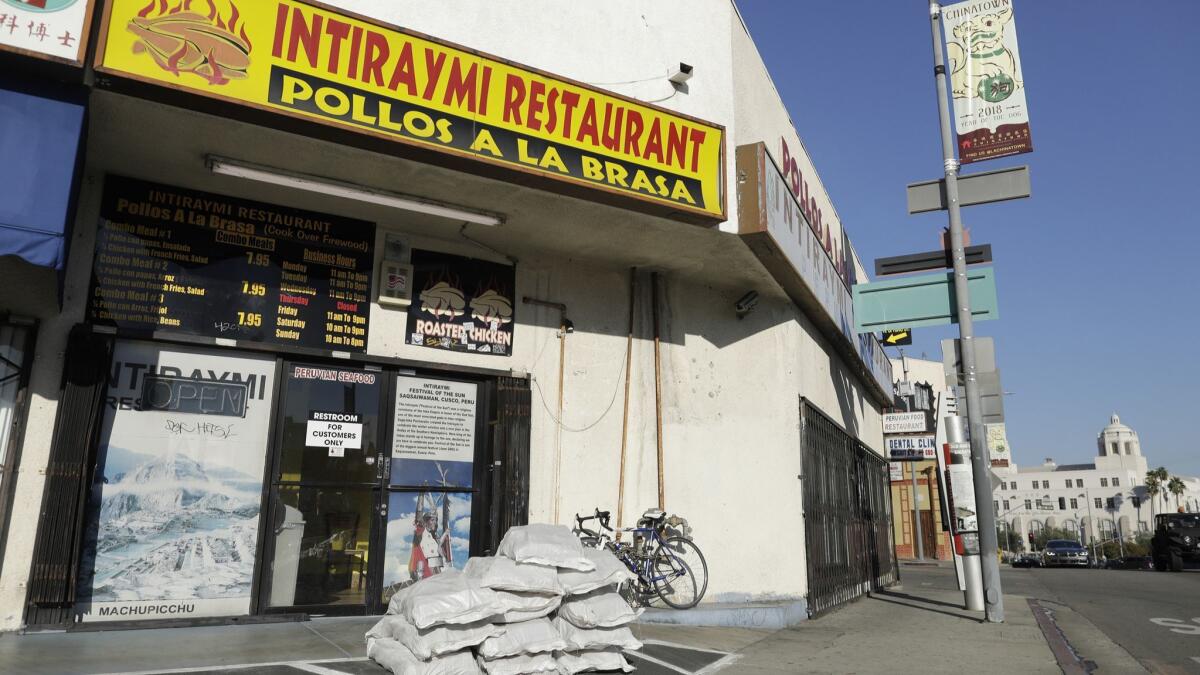
In recent years, as Peruvian cuisine has achieved a higher profile internationally — “it’s gotten really bougie really fast,” says Ore-Giron — Intiraymi represents, for the artist, a taste that is closer to home.
Born in Tucson to a Peruvian father and an Irish American mother (he is named Eamon, in honor of Eamon De Valera, the early 20th century Irish Republican leader ), Ore-Giron has called Los Angeles home base for the past 15 years, since he landed in the area to complete his master’s in fine art at UCLA.
His art draws from Peruvian rites (such as the 2011 video “Bite Work,” inspired by the Andean folk dance la chonguinada), but it also explores themes that resonate through the Americas, including issues tied to land and displacement, music and myth. This past spring, he created a two-story mural as part of the Hammer Museum’s 2018 “Made in L.A.” biennial that reflects an ongoing interest in pattern — pattern inspired by indigenous motif and 20th century geometric abstraction from Europe and Latin America.
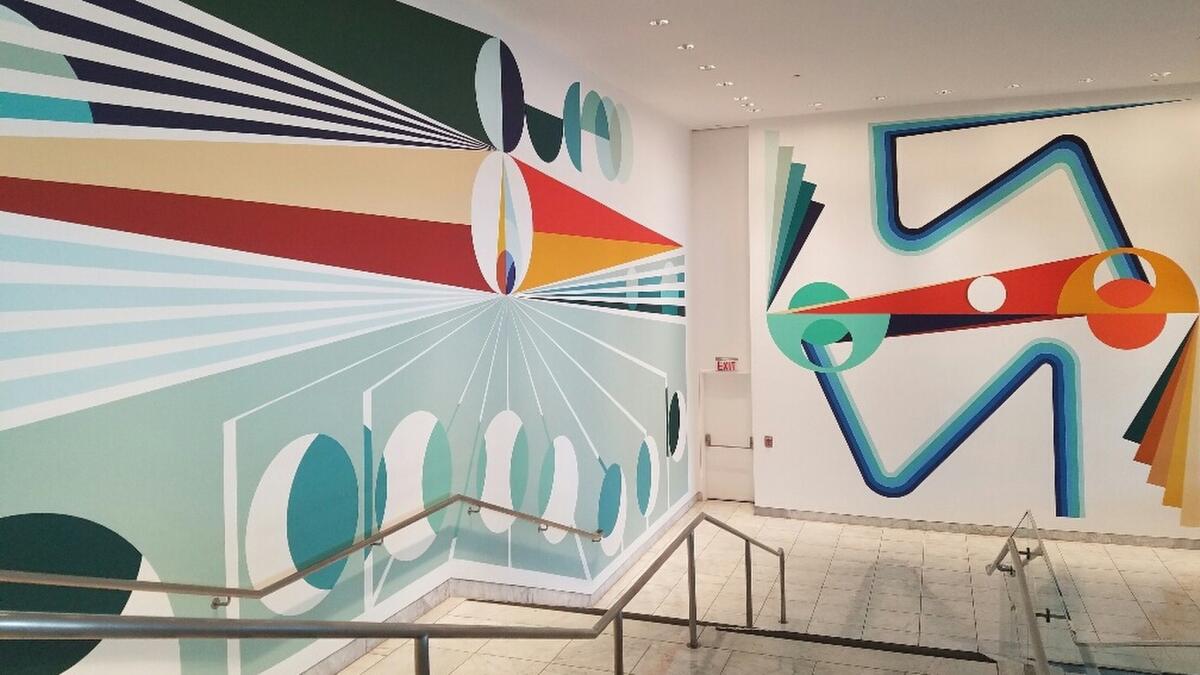
Ore-Giron first wandered into Intiraymi roughly a decade ago after picking up his father at nearby Union Station. The pair were in need of lunch and they chose Intiraymi, which sits on the urban seam between Chinatown and Olvera Street.
Except for a prominent mural of Machu Picchu, Intiraymi feels less like a collection of Peruvian tropes geared at American diners than the sort of practical Lima lunch hall where you can eat well for a few soles (the Peruvian currency, which is named for the sun). There are are no fluttering pan pipes on the sound system or baroque displays of tourist tchotchkes. Instead, a dozen tables are sandwiched between walls of bright yellow and a pair of televisions broadcasting soccer and crime shows.
“I’m the product of many different things,” Ore-Giron says of his work. “I think what I’m always trying to span is this space between South America and the U.S.” He finds that space at Intiraymi, a restaurant sustained by the thrum and churn of the city but rooted in the importance of serving a cuisine that for some, including Ore-Giron, offers a connection to tradition and history.
The menu covers the classics: ceviche, roasted chicken and the ever-popular lomo saltado, beef stir fried with onions, potatoes and soy sauce — Peru’s answer to Asian fusion. But their strength lies in their hearty stews, of the sort that can single-handedly ward off the high-altitude chills of the Andes. Dishes like olluquito con carne, an Andean tuber stewed with beef, garlic and ground chiles, count among them, as does Ore-Giron’s favorite, the earthy seco, which is served with an architectural dome of white rice, creamy frejol peruano (canary beans) and lightly pickled red onion.
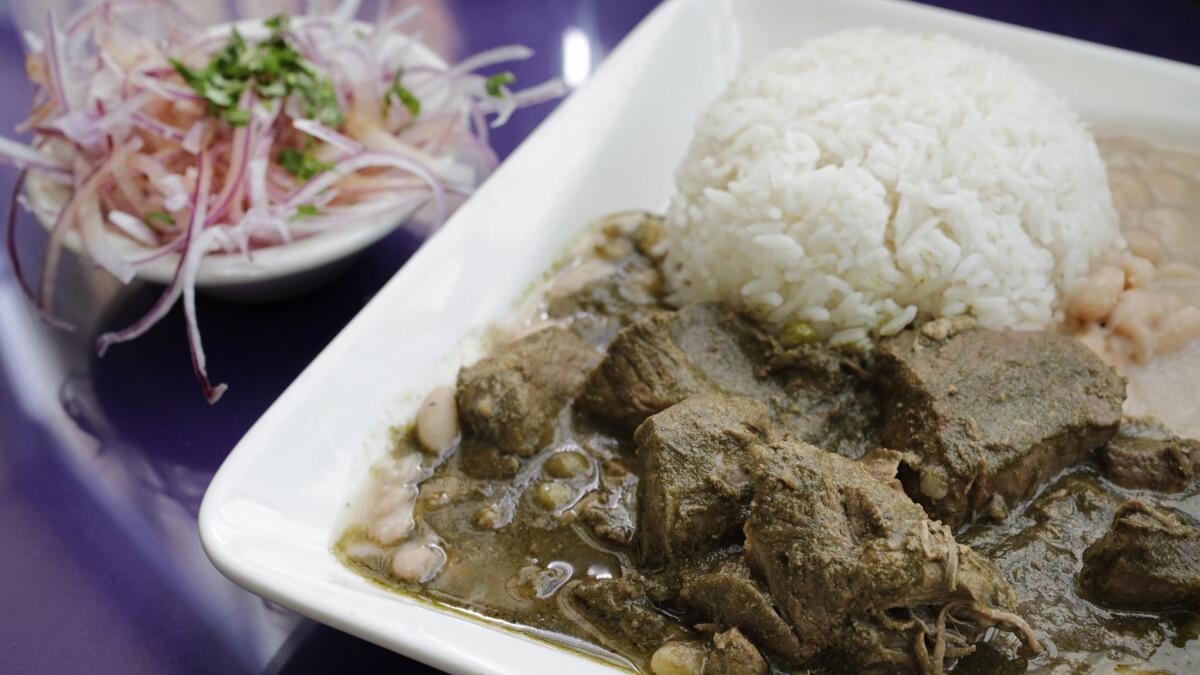
The story of Intiraymi is as practical as its aspect. Its proprietor is the low-key Fabián Nahui, a Peruvian immigrant from the central Andes (near where Ore-Giron’s family is from), who opened the restaurant in 1999. Nahui had been in the U.S. for only a handful of years at that point, working with a brother at an immigration services office in downtown. At lunch, he would regularly pop into the cheap Thai place that once inhabited Intiraymi’s storefront.
“One day, the owner said, ‘I’m moving, do you want this spot?’” he recalls. “I thought about it for a week and then said yes.”
He had never run a restaurant, nor was he even an aspiring chef. In fact, when I ask him what his specialties as a cook are, he says, with all seriousness, “Eating” — then cracks a wry smile. But the business opportunity presented by the imminent vacancy was too good to pass up. Nahui had noticed that the strip mall attracted a steady lunch crowd, and on weekends, Peruvian families would often materialize in the area to attend Mass at the nearby Our Lady Queen of Angels Catholic Church.
“Peruvians from all over,” he notes, “land here.” The first two years, he recalls, were difficult — “a lot of work,” he says. But Intiraymi soon found its groove among an only-in-Los Angeles crowd of all races and tastes, as well as packs of Peruvians looking for an unfussy taste of home.
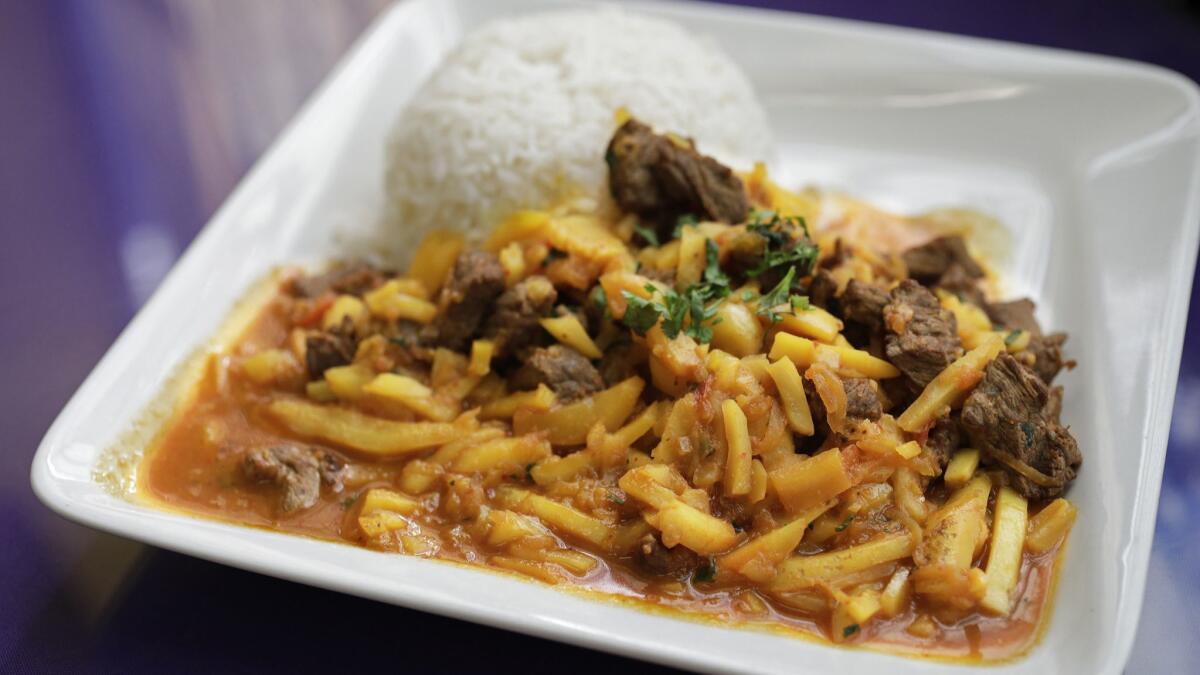
For Ore-Giron, the restaurant conjures so many associations. Intiraymi’s food — down to the garlicky white rice — reminds him of his father’s home cooking; deeper down in the menu he finds evocations of memories of visits to Peru, when his father and uncles would gather around steaming pachamanca, a traditional mix of meats, tubers and humitas (a type of Andean tamale) baked in the earth under hot rocks — and devour it with qapchi, a spread of cheese and chile paste.
“It’s one of my memories of being in the mountains,” says Ore-Giron, “putting everything in the big pot then dumping it on the table and there’d be these steaming piles of potatoes and they were blue and red.”
“Intiraymi,” says Ore-Giron, “reminds me of my uncles. Don Fabián reminds me of my uncles.” It is not an Instagram restaurant, not a hot spot, not a place to see and be seen. It is a restaurant at the heart of a community, or as Ore-Giron puts it, “It’s just the little restaurant that could.”
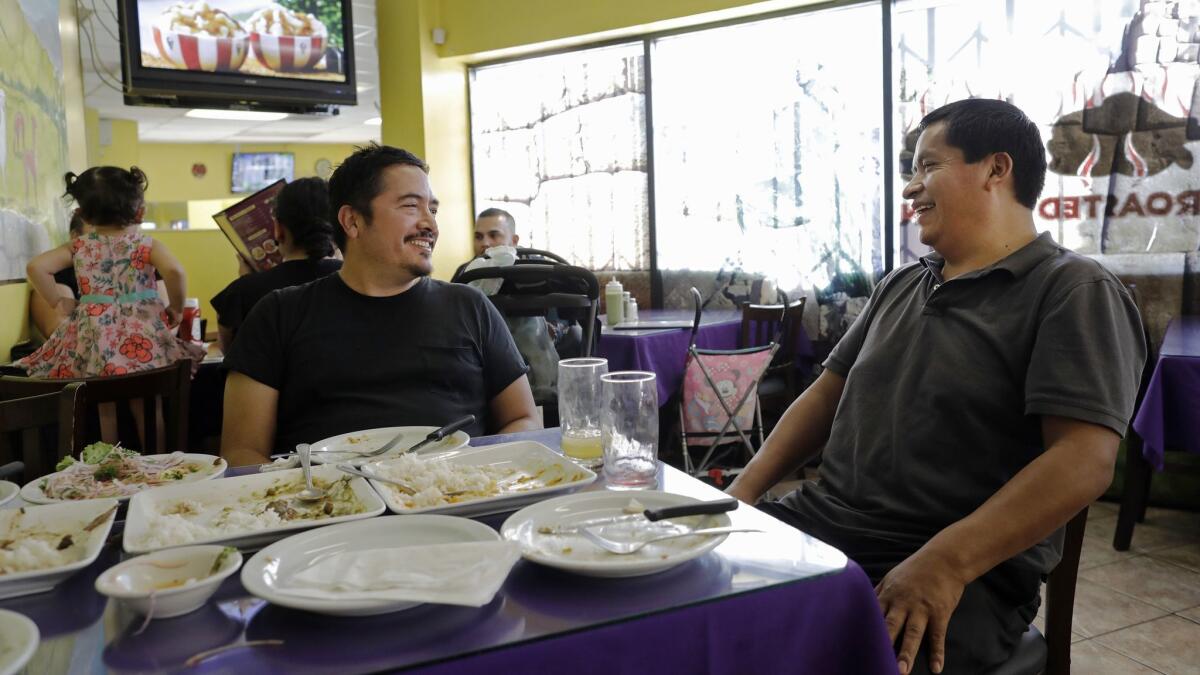
ALSO
Ricardo Zarate’s Rosaliné is a Peruvian party. Jonathan Gold orders a pisco sour and has some fun
I gave up on turkey at Thanksgiving and built an American melting-pot meal instead
Want to eat out on Thanksgiving? 20 great restaurants we’d go to
[email protected] | Twitter: @cmonstah
More to Read
Eat your way across L.A.
Get our weekly Tasting Notes newsletter for reviews, news and more.
You may occasionally receive promotional content from the Los Angeles Times.











